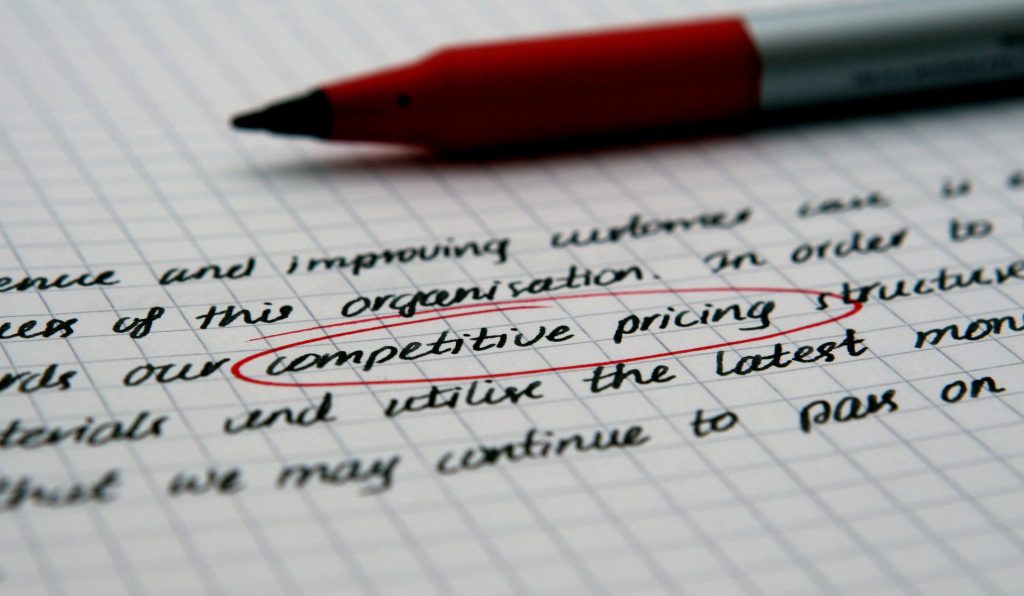Jules: “You read the Bible, Brett?”
Brett: “Yes!”
Jules: “Well, there’s this passage I’ve got memorized that sort of fits this occasion. Ezekiel 25:17. The path of the righteous man is beset on all sides by the iniquities of the selfish and the tyranny of the evil men. Blessed is he who, in the name of charity and goodwill, shepherds the weak through the valley of darkness, for he is truly his brother’s keeper, and the finder of lost children. And I will strike down upon thee with great vengeance and furious anger those who attempt to poison and destroy my brothers”.
Sometimes a day in the life of a pricing manager can feel like you’re starring in a Quentin Tarantino film. Tarantino’s films are characterized by nonlinear storylines, satirical subject matter, and an exploration of violence.
Yep, that sounds like a week in pricing…and we haven’t even left the office to go visit a customer yet.
When you eventually do get to meet with the customer, have you ever felt like there’s a gun to your head and you need to offer a lower price? Sometimes the gun is in our mind and it is our imagined threats that are almost always worse than reality. Maybe be it was just a banana all along and maybe they were just pleased to see us.
There are many pricing myths or fictions that we all live under, until one day we have an epiphany or just decide to make a change to see what happens–and we rationalise the decision with extensive data analysis post the fact. In this article, we will cover a number of “price fictions” that Pricing Insight has come across over the years.
The #1 price fiction sequence of thoughts we hear from clients and prospects is that their business is more complicated than most businesses, they are different than most businesses, and they have become commoditised. Yes, these things are all true….if that is what you believe. Welcome to Price Fiction.
Price Fiction #1: We are a commodity and the market sets the price.
Unless you are traded on the spot market of the London Metal Exchange or the Chicago Mercantile Exchange, no product, service or a solution is truly a pure commodity. As Shakespeare once said, “only thinking makes it so”. The commodity perception arises when one believes they are selling products or services, not solutions or experiences. To understand this better, try and sell the concept of Google as a series of complicated algorithms. It doesn’t really work. But sell it as a gateway to almost all human knowledge (or imagination), a solution for your next assignment (relief), a way to find your next career move (survival & self-actualisation) and you have a hit on your hands.
Too many products and services are pitched as the sum of their component parts or a series of transactional benefits. They are not sold with the real value to the customer worked out, communicated, and negotiated—or with a price built around the value to the specific customer. When the culture of “we are a commodity” creeps into the business, it is hard to get prices rises through. Sales reps start apologising to customers for price increases and reps feel more pressure to offer price discounts. It is a margin death spiral.
So the next time you hear the phrase “we have become commoditised,” ask this question: “Are we traded on an exchange?” If the answer is no, then you are not a commodity and you do have some power to determine the prices you set in the market place.
Solution:
Every customer has a different “want state”, which implies a specific set of desires. Every customer has a different risk profile, timeline, and speed of delivery expectation. You need to look at your pricing and revenue model and determine if your pricing structures reflect the various want states and demand drivers of your customers. The most obvious opportunity here is to move away from one price for all customers under all purchase conditions and start segmenting the customer base using a pricing structure that is aligned to the various customer types and behaviours. For example, charging price premiums for express service.
Price Fiction #2: Look after the top line and bottom line looks after itself
I was once told this by a sales rep at a conference. I actually looked into the concept, and it is possible to look after the bottom line by driving market share and volume…..when your gross margins are greater than 50%. If you are in the soft drink, software or soft toy industries, all of which make > 50% gross margins, drive on. But if you are in the other 80% of industries where average gross margins are under 40%, with EBIT margins of less than 15%, then driving volume at the expense of price doesn’t work. The break-even profit mechanics of price elasticity kick in and you can’t sell enough to cover the reduction in gross margin.
Solution:
Identify which products have an expansive consumption profile vs. a mortgaged consumption profile. Expansive products are like the Tim Tam chocolate biscuit which has a half-life of 45 minutes after being opened. If you discount these chocolate biscuits by 20%, you will get an uplift of 2-3x average weekly sales. In the following week, the regular baseline sales return to normal, i.e. expansive consumption has just been realised. This product also meets our high (50%+) gross margin criteria. Contrast this with a packet of Kettle Chips, which have lower gross margins, and when a discount of 20% is applied you will be lucky to get an uplift of 1.5x average weekly sales. Sales in the weeks following the price promotion will be depressed by 10-20%. This is mortgaged consumption.
For industrial B2B markets, price promotions are about as mad as it gets. Don’t do them–don’t use price bribes to do B2B business. Re-look at your contract structures/ trade agreements, review your list prices at a material or SKU level and make sure your next price increase is realised, rather than shooting for 5% and getting a net 1.75% price increase.
Price Fiction #3: The lowest price wins the deal
If this were true, then ALDI would have sent the major retailers out of business, Tiger Airways would be the only airline, the Formula One hotel chain would be everywhere and the only pizza chain would be Domino’s. We only hear that the lowest price won the deal because that is what buyers need to make sure you, as the seller, know is how deals get done. Yet there are high margin sales made every day. All things being equal, these were not the lowest prices on the day of the sale. Check your own data history.
Solution:
Look at the highest price products and customers with the highest average selling prices. Rank these sales statistics, then go through each and every one and identify the reason they pay price premiums for your products. What do you find? Yes, that’s right: There are lots of different reasons why you can get higher than average prices. Keep going with this exercise; it will put money in your pocket.
Share these reasons with other team members in the sales and marketing. Keep building these reasons out and then use them to develop your next negotiation strategy.
Price Fiction #4: The sales force need to be able to offer their own discretionary discounts to win the deal
This would be fine if the world was full of gross margins greater than 50%, and if the internet, email and mobile phones did not exist.
Giving sales people the freedom to offer discounts that they feel are necessary is truly one of the best ways to burn margin. Maybe the only faster way is to show them costs.
Sales people, in one-on-one discussions–or even reading this article– may think “I don’t offer excessive or commercially damaging discounts; therefore this statement may not be true”. However, I am willing to bet that because you are reading this, you are in the top 50th percentile of your peers–and by default, 50% of your sales force is below average and do offer these excessive discounts.
The cognitive biases associated with the pressure to make budget, being told you’re too expensive every day of your sales career, seeing your colleagues make sales from quick discounting and feeling the “fear” of not winning, drives all sales people to make ill-advised decisions. If you’re a sales person reading this now, this doesn’t apply to you as I know you would never fall prey to these pressures. You also fly through the air and find kryptonite rather unpleasant. The rest of us mere mortals have to wrestle daily with the dozen or so micro-decisions that come with being in sales. Should we cave in and give them an extra 5%? They really won’t pay for 60 days?
Solution:
Ensure that the sales force is given a centrally distributed tactics menu. The menu is built from the detailed analysis undertaken by your friendly pricing manager / analyst team. The tactics menu provide the sales teams with:
- The appropriate price band guidance
- % discount from list price
- certain criteria that must be met, or performance-based rebates paid quarterly to maintain focus and drive the right customer behaviours.
Review your tactics menu each quarter and refine as necessary. Develop new tactics as needed. The other crucial plan of attack is to build a more powerful belief system than your customer or prospect. Study your customer’s problems and pain points from variety of lenses / personas and develop a deep-set belief in the value of the solutions you can provide for the customer’s pain and problem set.
These beliefs need to be read aloud daily—so that your team starts each morning with a deep-seated belief in their value. This practice helps set build faith and perseverance in the face of intense price criticism or negotiation ploys engaged by customers.
Price Fiction #5: You need to understand your costs before you set your price.
Cost information determines the amount of capital or resources to invest in a particular market, once the price point has been determined based several value pricing techniques and principles. It was great for two thousand years of commerce to say “It costs $5 to make, so let’s sell it for $10”.
The world has changed. Cost Plus pricing is called “Cost Plus” because it will cost you plenty of lost margin in the long term.
Solution:
Explore the concept of “value-based pricing”—setting your prices based on what your customer perceives your product or service to be worth.
Price Fiction #6: Market share drives profitability
This thinking was developed and proposed by the same people who advised General Motors and Ford before they entered Chapter 11 bankruptcy. Apple has a 20% physical market share and an 80 – 90% share of industry profits.
You can’t get a loan against market share; it’s up there with your school report card as a measure of success. Yes, there is possible correlation between grades (your market share in school) and success, but market share should be thought of as a by-product of doing things right, not as an end in and of itself”.
Solution:
Talk about your business model, revenue model and pricing model, and hard economic numbers to keep your factory working or meet your business model target economics. Leave market share discussions off the table.
Price Fiction #7: Procurement are the economic buyers
I am sure procurement managers love the scene in Pulp Fiction where Marcellus Wallace suggests he will get “medieval with the blow torch and the pliers,” or words to that effect. Countless sales managers have had their years of deep sales experience relegated to the corner by being forced to fill in the price in an Excel spreadsheet–and deal only with the procurement administrator who has been trained to say that all value is just a ticket to the game, and the deal will be selected on price alone.
I have seen and heard the Head Of Procurement (HOP) at St. George Bank say that he hoped the CIO had not met with the Sales Director for IBM, because that would give the game away. The HOP stated that it was his job to convince the IBM Sales Director that the IBM product was just like 5 other vendors they are considering–and any additional features or benefits are just marginal or not relevant to the decision process, which will be made almost entirely on price.
Another favourite procurement phrase from central casting is “we have benchmarked you against a range of alternative vendors and you are 30% too expensive”.
I even had a procurement advisor from Ernst and Young tell me this when we were negotiating with Healthscope on behalf of an outsourcing company that supplied paper and stationery to the hospital system.
This stationery supplier is the biggest in the southern hemisphere. Their gross margins were 27% and EBIT margins were 6% (all on public record, as the company was ASX listed at the time. I asked if we could switch all $700M of our purchases across to his “benchmark supplier” so then we could make an extra 3.0% points–given that he could buy so much cheaper than us. He could not name the alternative supplier because they didn’t exist. The EY consultant simply took the cheapest line item from a multiplicity of sources to create a synthetic competitor.
Procurement functions in many instances—but not all—are commercially irresponsible and disingenuous in their dealings with sales teams.
I know that procurement managers reading this will disagree, but the evidence is overwhelming. Immature procurement teams try to negotiate on invoice price. Professional procurement teams negotiate lifetime value in use and risk.
Solution:
Sales Directors, if you want to get medieval on the procurement manager, you need to follow these specific steps:
- Identify every potential party (including end-use customers further down the value chain) that could be impacted by the purchase–or non-purchase–of the items or services in question.
- Identify the economic, professional and social rewards and risks associated with each persona.
- Develop a dollar estimate of these benefits and risks, customised to each persona.
- Invite key personas to a workshop to discuss proposed changes and investment in your supply chain.
- Explore each of the hypothesised value drivers and look for an opportunity to extract “value confessions” from the target customer.
- Create compelling communications to reach these personas and make them care, based the previous workshop’s value confessions.
- Create direct mail communications to each persona that explore in more detail the value and risks of the deal in question.
- When in negotiations with a procurement team member, indicate to them that their decision process will be documented and communicated to the relevant stakeholders.
- Only walk away and close the book first in a meeting when you have built substantial value-framing and positioning with the relevant persona stakeholders.
Will this method work every time? No. Try it on a small account first. But just filling in a spreadsheet template with your lowest price is guaranteed to drive your prices and profits lower. If none of these solutions are of value you best off, call Pulp Fiction’s Mr Wolf. He fixes things.
Did you like this article? You can download our PDF version here: Download PDF Whitepaper






